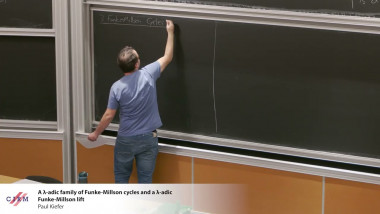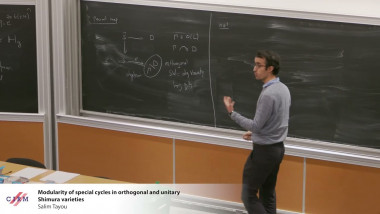
A $\lambda$-adic family of Funke-Millson cycles and a $\lambda$-adic Funke-Millson lift
By Paul Kiefer

Modularity of special cycles in orthogonal and unitary Shimura varieties
By Salim Tayou
By Pär Kurlberg
Appears in collections : Dynamics and graphs over finite fields: algebraic, number theoretic and algorithmic aspects / Dynamique et graphes sur les corps finis : aspects algebriques, arithmétiques et algorithmiques, Exposés de recherche
The number $F(h)$ of imaginary quadratic fields with class number $h$ is of classical interest: Gauss’ class number problem asks for a determination of those fields counted by $F(h)$. The unconditional computation of $F(h)$ for $h \le 100$ was completed by M. Watkins, and K. Soundararajan has more recently made conjectures about the order of magnitude of $F(h)$ as $h \to \infty$ and determined its average order. For odd $h$ we refine Soundararajan’s conjecture to a conjectural asymptotic formula and also consider the subtler problem of determining the number $F(G)$ of imaginary quadratic fields with class group isomorphic to a given finite abelian group $G$. Using Watkins’ tables, one can show that some abelian groups do not occur as the class group of any imaginary quadratic field (for instance $(\mathbb{Z}/3\mathbb{Z})^3$ does not). This observation is explained in part by the Cohen-Lenstra heuristics, which have often been used to study the distribution of the p-part of an imaginary quadratic class group. We combine the Cohen-Lenstra heuristics with a refinement of Soundararajan’s conjecture to make precise predictions about the asymptotic nature of the entire imaginary quadratic class group, in particular addressing the above-mentioned phenomenon of “missing” class groups, for families of $p$-groups as $p$ tends to infinity. For instance, it appears that no groups of the form $(\mathbb{Z}/p\mathbb{Z})^3$ and $p$ prime occurs as a class group of a quadratic imaginary field. Conditionally on the Generalized Riemann Hypothesis, we extend Watkins’ data, tabulating $F(h)$ for odd $h \le 10^6$ and $F(G)$ for $G$ a $p$-group of odd order with $|G| \le 10^6$. (To do this, we examine the class numbers of all negative prime fundamental discriminants $-q$, for $q \le 1.1881 \cdot 10^{15}.$) The numerical evidence matches quite well with our conjectures. This is joint work with S. Holmin, N. Jones, C. McLeman, and K. Petersen.
